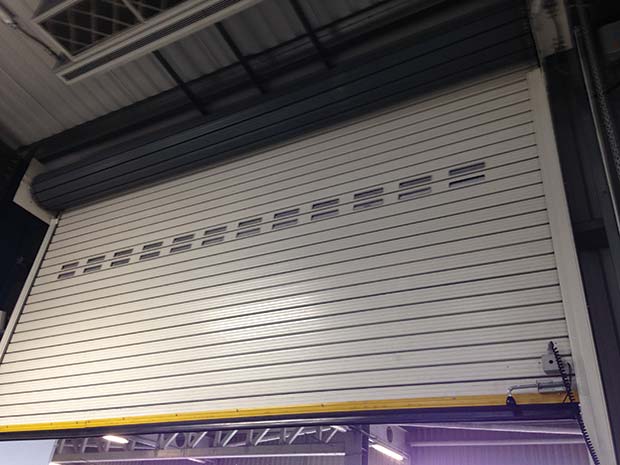Thermal regulation is vital to the ongoing performance of the chilled food distribution network, a multibillion dollar global industry. Getting rooms down to temperature is one thing, keeping them at that temperature in the most efficient manner is another. Nick Cox, Area Sales Manager of loading bay specialist, sara LBS, explains how the right door can improve insulation to maximise profits and help preserve the perfect temperature.
 Food distribution is an internationalised business these days; based on a network of distribution centres and highly efficient freighting operations. What it achieves on a macro level is truly astonishing. For instance prawns caught off the west coast of Scotland can be with discerning consumers in Spain, France and Italy while still at the peak of freshness. And those same fishermen can enjoy out-of-season tomatoes and melons grown under glass in southern Europe.
Food distribution is an internationalised business these days; based on a network of distribution centres and highly efficient freighting operations. What it achieves on a macro level is truly astonishing. For instance prawns caught off the west coast of Scotland can be with discerning consumers in Spain, France and Italy while still at the peak of freshness. And those same fishermen can enjoy out-of-season tomatoes and melons grown under glass in southern Europe.
Perhaps even more astonishing, some of that Scottish seafood will be flown to India to be picked, peeled and processed then flown back to Europe as finished dishes.
Keeping food at accurately controlled, reduced temperatures is essential in such operations if it is to be kept fresh, nutritious and wholesome. Not surprisingly then, there are strict regulations that must be followed, while the distribution centres bristle with technology to ensure standards are met and hygiene maintained.
 The core technology is refrigeration and air conditioning. Often entire buildings are cooled to carefully controlled levels. This is obviously an energy intensive process, so good insulation and best practice handling operations are essential to maximising productivity in such environments.
The core technology is refrigeration and air conditioning. Often entire buildings are cooled to carefully controlled levels. This is obviously an energy intensive process, so good insulation and best practice handling operations are essential to maximising productivity in such environments.
For food distribution companies looking to keep large spaces cool and hygienic, sara LBS offers several industrial door and loading bay solutions which offer high levels of insulation.
Starting from the coldest, frozen food areas need to be kept very cold, but must have means of access for personnel and/or vehicles. In such cases we would generally look to a sliding door solution; sized as appropriate, but basically as small as practically possible in order to minimise warm air ingress. Typically such a door would be lined with around 120mm of insulation for best performance.
Ideally we recommend that freezer doors are powered, rather than manually operated, to reduce the possibility of operatives leaving the door open during non-operational periods. It also allows for a degree of automation: timers, presence detectors, temperature sensors and other equipment can be fitted so that the door closes automatically or an alarm sounds if the door seems to have been left open unnecessarily.
For chilled areas that need protecting from ambient, outside temperatures, the next level down from sliding doors would be the sara LBS range of Sprint insulated, highspeed roller shutter doors. These are available with 40mm or 80mm of insulation and are typically installed between the production floors and the loading bays, where lorries arrive to deliver or receive chilled foods. They may also be used as the outside door of the loading bay, although in some cases an uninsulated roller shutter door may be preferred. It is notable that the aluminium profiles of the Sprint 3000 range provide a ‘first line of defence’ against vandalism while also preventing the entry of small animals and birds in search of food or shelter.
High speed roller doors are generally recommended, especially for large openings because they can increase the amount of time they are actually shut considerably, particularly in busy locations where frequent opening is required. Again, because the doors are motor driven, levels of automation can be adopted to enhance and improve operations. In chilled food distribution centres, sara LBS often also recommends that the outer side of the loading bays are fitted with inflatable vehicle shelters, as they are very good for keep chilled air in and warmer atmospheric air out.
Many food operations will have their facility divided into sections and these may require different temperature levels. In order to assist with this, sara LBS often recommends high speed roller curtain doors. These can open and close very quickly and automatically as a person or fork lift truck approaches. Further the curtain, typically made of PVC, can be transparent so that operatives can see through to them and proceed confident that their way ahead is clear and safe.
Ultimately, specifying the right door for your chilled environment can play one of the most crucial roles in how efficient your cooling operations are, yet in the grand scheme of things it’s a fraction of overall investment. sara LBS engineers have a wealth of experience specifying and installing doors in many different environments and will help you to choose a solutions that will work best for you. All of our doors are supported by nationwide maintenance and repair services so you will have peace of mind that we’ll continue to support you long after the sale.
SARA LOADING BAY SPECIALISTS
Tel: 01442 245577
Email: info@saralbs.co.uk




Comments are closed.